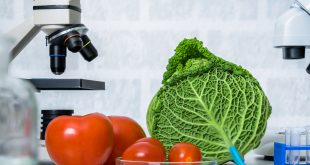How Canadian food manufacturers will benefit from digitalization
By Markus Brettschneider
From automotive and aerospace, many industries have been using digitalization technologies, such as automation and robotics, for many years. This goes hand in hand with the idea of the Industrial Internet of Things (IIoT), where connectivity of devices opens up new possibilities to improve production. However, the food and beverage sector has been slower to adopt these new technologies. In Canada, the government and industry are looking at what could be done. This article explores how digitalization has transformed from a trend into a core component of modern food business strategies.
Canada is the fifth largest exporter of food products in the world and generated $32.3 billion in 2016. Because food manufacturing makes up the largest manufacturing sector in Canada, the Canadian government and the Conseil de la transformation alimentaire du Quebec (CTAQ) recently partnered with ABB to host the country’s first National Food Technology Event.
The event, held in September, aimed to educate businesses of all sizes on how to ensure sustainability and growth of the Canadian food industry through the integration of digitalization. Focusing on key industry topics such as automation, industry 4.0 and artificial intelligence, ABB presented the reasons why food manufacturers should be making the most of digitalization and the benefits it can have to those in the industry.
The big picture
While digitalization is transforming the way that industrial environments operate, the food manufacturing industry has been slow in adopting and integrating these new technologies. This is despite research firm PwC reporting that 90 per cent of companies expect digitalization to increase their competitiveness, as analytics from smart technology provides businesses with knowledge about what their customers think and what they want.
The results of PwC’s Industry 4.0 global survey suggest that most businesses believe they do not have the right talent, IT infrastructure or defined strategy to implement digitalization and the IIoT. This is particularly true for companies who already have an existing set-up and are looking to embark on their digital journey within their existing manufacturing footprints.
This research is confirmed by ABB, which also conducted its own survey and found similar results. Although this initial hesitation is to be expected from manufacturers, in the U.S. and Canada the demand for manufacturers to optimize their supply chains is greater than ever.
As consumers expect more convenience and accessibility, companies such as Amazon and Walmart are seizing the opportunity to endorse new ecommerce business models, and active investors are pushing manufacturers to simplify and optimize their supply chains. Digitalization, automation and robotics offer solutions to these challenges.
What’s impacting demand?
Both Amazon and Walmart have been leading the development of the grocery ecommerce market, which has grown significantly since it was first developed in 2007. Revolutionizing the way consumers shop for food so that it is easy and convenient for the consumer, ecommerce systems also allowed retailers to provide a greater amount of choice.
With that said, the high level of choice means customers can compare prices across different retailers quicker online than in store, driving greater competition between companies as a result. As mergers like Amazon and Whole Foods happen, more pressure will be put on manufacturers to meet retailer demands.
Why digitalization?
Today, many of our household appliances are connected to the internet. We can control our televisions, washing machines, and even look into our refrigerators from our mobile devices. The low cost of connectivity enables this, combined with easily accessible and secure cloud services and storage. Today, technology has advanced so much that cost is not a barrier to connect a device to a network, whether it’s a consumer device or an industrial one.
In the same way that digitalization allows consumers to interact with their fridges, it also facilitates better engagement for engineers in the industrial food and beverage sector. For example, the ABB Ability Smart Sensor for motors is a device that connects to existing low voltage motors. It collects motor performance data, such as temperature and vibration levels. This data is collected in the cloud where analytical services provide plant engineers with a simple overview of the health status of their motors.
This changes the maintenance concept from reactive, meaning service is done when a problem happens, to predictive; knowing ahead of time and scheduling maintenance before the problem happens.
Ecommerce grocery shopping is just one example of a change in buying behaviour in the U.S. and Canada. Other trends include the rise of vegan, gluten-free and dairy-free foods, as well as a shift in packaging materials and designs. Consumers are looking for portion sizes that allow them to reduce the amount of food they throw away.
In turn, manufacturers are being compelled to create a variety of serving sizes, such as single-serve packaging, multi-packs and resealable packs. To enable this, manufacturers need to efficiently adapt production lines to accommodate these new products.
Robotics are a key enabler and, even before a robot is installed, digitalization helps make the process more efficient. For example, virtual commissioning allows plant engineers to create a 3D model of the proposed process line change, program robot and other automation, and then test the whole line prior to making any physical changes. This not only saves time, it is an economical and fast solution that helps manufacturers become more flexible in a shorter timeframe.
Supply chain pressures
In Canada, and around the world, manufacturers are increasingly analyzing their supply chains, from grass to glass and farm to fork. Understanding how ingredients are used across production and being able to analyze production data, while maintaining tracking and traceability for food safety, is a complex task.
Digitalization at the enterprise level, such as Manufacturing Operations Management systems, help integrate and track diverse production information. The data gathered feeds optimization analysis. This data helps manufacturers identify where and how optimizations can be made, including in the usage of utilities such as water and electricity.
The National Food Technology Event in Canada helped open the discussion about digitalization and shows the importance for both the country and the industry to ensure the future of food manufacturing remains competitive in Canada, and globally.
Consumer buying habits will continue to change and the demand for greater choice will grow. Manufacturers need to be prepared to adapt and respond quickly; and the more they know about the possibilities digitalization enables, the more competitive they will be.
Markus Brettschneider is Group Senior Vice President and General Manager of Global Food and Beverage Applications at ABB
 Canadian Food Business
Canadian Food Business




